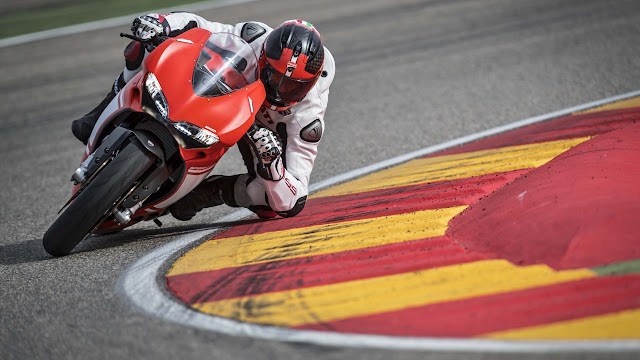Ducati 1299
specs and review
Ducati raises the bar for semi-production race bikes with its limited edition 1299 Superleggera. A space-age, carbon-fiber frame, swingarm and wheels carry Ducati’s most powerful twin-cylinder mill to date with 215 horsepower on tap to push a mere 368 pounds. Yeah, that’s right. The good news is that Ducati installed everything it could as far as electronic features go to help riders control all that power and keep the thing dirty-side down. I’m talking a veritable alphabet soup of gadgetry here, so let’s dig in and start deciphering it.
SPECIFICATIONS:
DESIGN :
Built for speed, the windtunnel-tested shape was painstakingly designed to minimize losses to weight and drag. The structure depends upon a monocoque system that uses the carbon-fiber fairing as a stressed member to complete the assembly. Needless to say, there were significant weight savings here, especially when you consider that the frame itself comes made of carbon-fiber material, as well. Inserts made of 7075 aluminum are laminated into the structure at key points to reinforce and strengthen without adding appreciable weight or bulk.
PERFORMANCE:
As great as this bike looks so far, the real magic is found in the engine and its control systems. Much like the rest of the bike, the factory took steps to lighten the engine through the use of titanium valves and fasteners. Aluminum cylinder liners, titanium connecting rods and tungsten balance weights contribute to the 4.6-pound advantage the Superleggera mill enjoys over the version that goes into the 1299 Panigale. This engine is massively oversquare with a 116 mm bore and only a 60.8 mm stroke, but don’t take that to mean it slacks off in the torque department; at 9,000 rpm it manages to grind out 108 pound-feet of torque backed up by 215 ponies that come on at 11 grand for what Ducati has dubbed its most powerful twin cylinder to date. Redesigned pistons pump the compression up to a sizzling 13-to-1, so yeah, you can forget about burning anything less than the best road champagne you can find.
PRICING:
The price, well, it’s kind of a moot point, isn’t it? If you didn’t get the memo, the limited-edition run of 500 units sold out pre-production, so the $89,000 pricetag hardly matters now.
COMPETITORS:
Since carbon fiber is such a prominent material on the Superleggera, I couldn’t help but think of another carbon-based creation; the HP4Race from BMW. It’s fair to say that both incorporate a fair amount of engineering and testing of the cowling shape to make them as fast as possible, but BMW saved itself the trouble of mounting lights and mirrors for road use; the HP4 is meant for closed-circuit use only. Beemer utilized carbon-fiber engineering in the frame, but doesn’t take the plastic treatment nearly as far as Ducati does on the Superleggera, even though the HP4 also runs as a stressed-skin, monocoque assembly.





What a sweet bike, Rajat. Been seeing more of these around recently. So sleek and sexy.
ReplyDelete